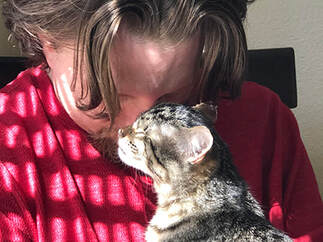
Most cat owners are happily familiar with the warm and fuzzy feeling of being headbutted or “bunted” by their favorite felines. But have you ever wondered what’s behind that ever-so-famous behavior? If so, read on.
Pheromones, pheromones, pheromones! Kitties have glands on their foreheads, cheeks, behind their ears, and on their chins that contain this all-important substance. Produced as a form of scent communication in their environment – between fellow cats as well as on objects and, best of all, people – these pheromones are deposited by the acts of rubbing and headbutting.
Cats may headbutt and rub their face on such familiar objects as their cat tree or pieces of furniture. In so doing, they’re “marking” or claiming these objects in a paws-itive way, i.e. personalizing their surroundings and creating a safe space for themselves. They’re usually purring as well because they’re not only feeling relaxed and content, they’re thoroughly enjoying the scent of their very own pheromones. This form of solitary face rubbing may also be one of the ways in which they soothe themselves and regulate their own emotional state.
If a cat headbutts you, her pet parent, by tapping her head against you and rubbing her cheek along the body part nearest to her, she’s clearly ”marking” you as well. By connecting to you through her scent, she is, in effect, “choosing” you and therefore bonding with you. While you may not detect it, the mere fact that you smell like her is extremely reassuring to her. The clearest sign of affection there is, by claiming you, she’s, metaphorically, admitting you into her “inner circle” of favorites.
Sometimes, however, if your kitty headbutts you, it’s her way of letting you know that she wants attention. Your response, when she “presents” her head to you in this way, should be plentiful scratches under the chin and on the head – two kitty cat passions! If her headbutting is consistently providing her with the scratches she craves, she’ll most assuredly continue this successful attention-seeking practice, thus creating a pleasant ongoing cycle or … a mutual admiration society of two.
Whenever an unfamiliar or newly adopted cat headbutts you, she’s usually checking you out – friend or foe. The wisest course of action is to move slowly and lower your head enough for her to sniff it and monitor her reaction. If she responds by headbutting you again, you could lightly headbutt her in return or, after an initial hand sniff for safety’s sake, gently scratch her head instead.
Many cats in a multi-cat household will headbutt their fellow felines as a show of affection. While the message will be clear to one and all, reactions to it can vary. Some cats may respond in kind while others may choose to ignore the gesture. Confident cats are known to headbutt more often and with more force than shy cats, and that the most self-assured among them will also be the household’s dominant cat.
Headbutting is even the way outdoor, semi-feral and feral cats communicate their connection with one another and establish a social bond between them. When cats within a colony headbutt each other, they’re actually mixing their scents in order to create a single scent. This unique blend is subsequently designated the colony’s scent and distributed to all of the cats in that particular colony.









 RSS Feed
RSS Feed